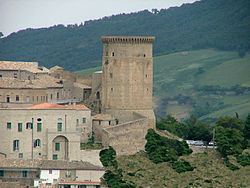Elevation 698 m (2,290 ft) Local time Wednesday 10:47 AM | Frazioni Calle Demonym(s) Tricaricési Postal code 75019 | |
 | ||
Weather 12°C, Wind NE at 8 km/h, 74% Humidity | ||
Tricarico (Greek: Triakrikon) is a town and comune in the province of Matera, Basilicata, southern Italy.
Contents
Map of 75019 Tricarico Province of Matera, Italy
It is home to one of the best preserved medieval historical centres in Lucania.
Etymology
The origin of the name Tricarico is unknown. According to one hypothesis, it cound be Triacricon, deriving from the Greek words treis ("three") and acron/acra (an apex, either a "citadel", or just a "summit"), with Triacricon meaning the city "with the three citadels". These three acra/citadels were no other than the site of the 9th c Arabic castle of Saracena in the north, the site of a 9th-10th c Byzantine Rocca fortificata in the south, improved during the 11th-12th c by the Normans, and then, during the 13th c, by the Hohenstaufen, and also the site of the 14th c Palazzo Ducale in the middle. Probably the three sites were simultaneously fortified even before the successive occupations.
History
Although of ancient origin, the first news documented about the town dates to 849, when it was a Lombard county included in the gastaldate of Salerno. Later (9th century - late 10th century) it was an Arabic stronghold. The terrace gardens, of Arabic origin, are still in use today. In 968 Tricarico was conquered by the Byzantine Empire, and then, in 1048, it became a Norman fortified town.
In the 15th century, there was a Jewish community.
Main sights
The roads and alleys of the historical center reflect the Arabic quarters of the Ràbata and the Saracena.
Sights in the town include:
The archaeological area of Civita is situated outside the city. It includes a Roman fortified center that extends for approximately 50 hectares (120 acres) and consists of stone buildings with squared blocks, fortified with monumental doors. In the interior, some rooms have mosaic pavements over 2,500 years old.
Also present is the Cerra del Cedro archaeological site, inhabited from as early as the 6th century to the 3rd century BC.
